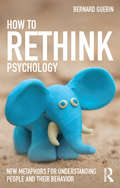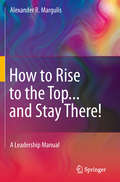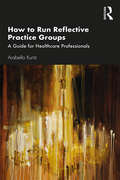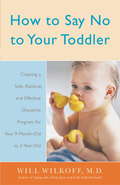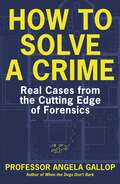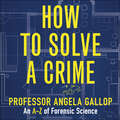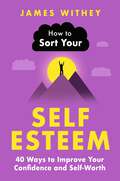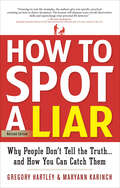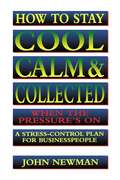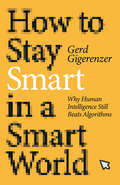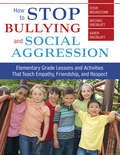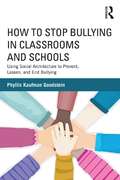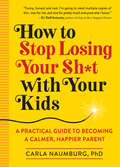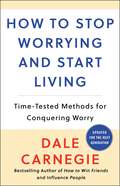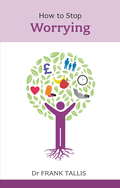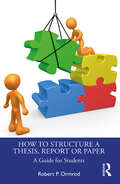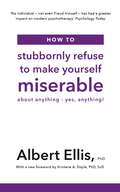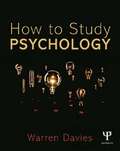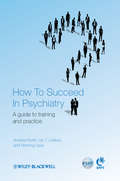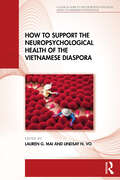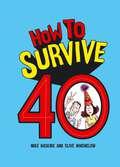- Table View
- List View
How to Rethink Psychology: New metaphors for understanding people and their behavior (Exploring the Environmental and Social Foundations of Human Behaviour)
by Bernard GuerinBased on the author’s forty years of experience in psychology, philosophy, and the social sciences, How to Rethink Psychology argues that to understand people we need to know more about their contexts than the dominant modes of thinking and research presently allow. Drawing upon insights from sources as diverse as Freud, CBT, quantum physics, and Zen philosophy, the book offers several fascinating new metaphors for thinking about people and, in doing so, endeavors to create a psychology for the future. The book begins by discussing the significance of the key metaphor underlying mainstream psychology today – the ‘particle’ or ‘causal’ metaphor – and explains the need for a shift towards new ‘wave’ or ‘contextual’ metaphors in order to appreciate how individual and social actions truly function. It explores new metaphors for thinking about the relationship between language and reality, and teaches the reader how they might reimagine the processes involved in the act of thinking itself. The book concludes with a consideration of how these new metaphors might be applied to practical methods of research and understanding change today. How to Rethink Psychology is important reading for upper-level and postgraduate students and researchers in the fields of social psychology, critical psychology, and the philosophy of psychology, and will especially appeal to those studying behavior analysis and radical behaviorism. It has also been written for the general reading public who enjoy exploring new ideas in science and thinking.
How to Rise to the Top...and Stay There!
by Alexander R. MargulisThe present dire economic environment has greatly affected business and the opportunities for advancement or even holding a job. Even universities, although not directly in business, are feeling the impact of diminishing endowments, resulting in lower disposable funds and reduction in innovative, unproven programs, which, in the past, often led to breakthroughs. These conditions we hope are only temporary, and they will not affect careers in the long run. This book is written to guide the reader on how to progress in his or her chosen career, how to reach a high position in which one is actually in charge of a unit, department, school, or business and how to run it successfully.
How to Run Reflective Practice Groups: A Guide for Healthcare Professionals
by Arabella KurtzIn How to Run Reflective Practice Groups: A Guide for Healthcare Professionals, Arabella Kurtz explores the use of reflective practice in the modern healthcare context. Responding to the rapidly increasing demand for reflective practice groups in healthcare and drawing on her extensive experience as a facilitator and trainer, Kurtz presents a fully developed, eight-stage model: The Intersubjective Model of Reflective Practice Groups. The book offers a guide to the organisation, structure and delivery of group sessions, with useful suggestions for overcoming commonly-encountered problems and promoting empathic relationships with clients and colleagues. Clearly and accessibly written, using full situational examples for each stage of the presented model, How to Run Reflective Practice Groups offers a comprehensive guide to facilitating reflective practice in healthcare.
How to Say No to Your Toddler: Creating a Safe, Rational, and Effective Discipline Program for Your 9-Month to 3-Year Old
by William WilkoffTeaching your toddler that “no means no” now can save you both suffering. But how do you say it so that he’ll understand?For many parents of toddlers, saying “no” over and over becomes a mantra for exhaustion. Why is it so difficult to convey the meaning of this tiny word? Because, says pediatrician Will Wilkoff, when it comes to tots, actions speak louder than words. Using very direct and simple guidelines, Dr. Wilkoff shows you how to develop a consistent and effective discipline plan. He explains what can go wrong with time-out and how to overcome obstacles, including your child’s rebelliousness, physical space issues, and your own reluctance. He also presents helpful advice for special situations, such as how to say no at meal times, at grandma’s house, and when your child is sick. Presenting his compassionate and practical approach, Dr. Wilkoff shows how you can respond to the misbehavior of very young children while teaching them self-control that will benefit them throughout their lives. How to Say No to Your Toddler is the ideal guide for any parent who wants to take a more effective approach for raising healthy, happy children.
How to Solve a Crime: Stories from the Cutting Edge of Forensics
by Professor Angela GallopOut now: The gripping new book by the UK's most eminent forensic scientists, Angela Gallop__________CRIME [Noun]: An action or omission which constitutes an offence and is punishable by lawForensic science is one of the most important aspects of any criminal investigation.The impartial and objective evidence it provides can help convict the innocent and incarcerate the guilty. It enables courts to have the confidence in their decisions and to ensure that justice is done. Professor Angela Gallop has been at the forefront of forensics for more than 45 years. During her remarkable career, she has established and run forensic science laboratories and has worked on thousands of cases in the UK and across the world. In How to Solve a Crime, she describes some of her own and her colleagues most intriguing cases and the wide range of skills and techniques used to solve them. Whether it's looking at blood patterns and footwear marks at crime scenes to work out what happened, extracting data from suspects mobile phones to discover where they were at critical times, or analysing fragments of textiles fibers, glass or paint to determine where they might have come from, Gallop shows that every contact really does leave a trace and every trace can help to solve a crime. With unparalleled access and insight across a wide range of specialisms, How to Solve a Crime is a fascinating definitive and authoritative account of real-life forensic science. _________Praise for WHEN THE DOGS DON'T BARK'Fascinating' Guardian 'Offers a chilling glimpse into her life's work. . . fascinating stuff' Sunday Times 'Compelling' Daily Mirror 'A casebook that reads like The Encyclopaedia of Murder' Daily Express 'One of the professions leading lights' Woman & Home
How to Solve a Crime: Stories from the Cutting Edge of Forensics
by Professor Angela GallopPre-order now: The gripping new book by the UK's most eminent forensic scientists, Angela Gallop__________CRIME [Noun]: An action or omission which constitutes an offence and is punishable by lawForensic science is one of the most important aspects of any criminal investigation.The impartial and objective evidence it provides can help convict the innocent and incarcerate the guilty. It enables courts to have the confidence in their decisions and to ensure that justice is done. Professor Angela Gallop has been at the forefront of forensics for more than 45 years. During her remarkable career, she has established and run forensic science laboratories and has worked on thousands of cases in the UK and across the world. In How to Solve a Crime, she describes some of her own and her colleagues most intriguing cases and the wide range of skills and techniques used to solve them. Whether it's looking at blood patterns and footwear marks at crime scenes to work out what happened, extracting data from suspects mobile phones to discover where they were at critical times, or analysing fragments of textiles fibers, glass or paint to determine where they might have come from, Gallop shows that every contact really does leave a trace and every trace can help to solve a crime. With unparalleled access and insight across a wide range of specialisms, How to Solve a Crime is a fascinating definitive and authoritative account of real-life forensic science. _________Praise for WHEN THE DOGS DON'T BARK'Fascinating' Guardian 'Offers a chilling glimpse into her life's work. . . fascinating stuff' Sunday Times 'Compelling' Daily Mirror 'A casebook that reads like The Encyclopaedia of Murder' Daily Express 'One of the professions leading lights' Woman & Home
How to Solve a Crime: Stories from the Cutting Edge of Forensics
by Professor Angela Gallop'Endlessly fascinating...meticulously written and thoroughly absorbing book' Financial TimesOut now: The gripping new book by the UK's most eminent forensic scientists, Angela Gallop__________CRIME [Noun]: An action or omission which constitutes an offence and is punishable by lawForensic science is one of the most important aspects of any criminal investigation.The impartial and objective evidence it provides can help convict the guilty. It enables courts to have the confidence in their decisions and to ensure that justice is done. Professor Angela Gallop has been at the forefront of forensics for more than 45 years. During her remarkable career, she has established and run forensic science laboratories and has worked on thousands of cases in the UK and across the world. In How to Solve a Crime, she describes some of her own and her colleagues most intriguing cases and the wide range of skills and techniques used to solve them. Whether it's looking at blood patterns and footwear marks at crime scenes to work out what happened, extracting data from suspects mobile phones to discover where they were at critical times, or analysing fragments of textiles fibers, glass or paint to determine where they might have come from, Gallop shows that every contact really does leave a trace and every trace can help to solve a crime. With unparalleled access and insight across a wide range of specialisms, How to Solve a Crime is a fascinating definitive and authoritative account of real-life forensic science. _________Praise for WHEN THE DOGS DON'T BARK'Fascinating' Guardian 'Offers a chilling glimpse into her life's work. . . fascinating stuff' Sunday Times 'Compelling' Daily Mirror 'A casebook that reads like The Encyclopaedia of Murder' Daily Express 'One of the professions leading lights' Woman & Home
How to Sort Your Self-Esteem: 40 Ways to Improve Your Confidence and Self-Worth
by James WitheyFeaturing 40 simple, practical and often amusing techniques, this book will help strengthen your sense of self-worth, whether your self-esteem impacts you on a daily basis or are experiencing a crisis of confidence for the first time.
How to Sort Your Self-Esteem: 40 Ways to Improve Your Confidence and Self-Worth
by James WitheyFeaturing 40 simple, practical and often amusing techniques, this book will help strengthen your sense of self-worth, whether your self-esteem impacts you on a daily basis or are experiencing a crisis of confidence for the first time.
How to Spot a Liar: Why People Don't Tell the Truth . . . and How You Can Catch Them
by Gregory Hartley Maryann KarinchFrom a US Army interrogator, expert advice on how to ask questions, assess body language and facial expressions, to extract the truth from anyone.Have you ever been lied to? Of course you have, whether you knew it or not. Ever caught a spouse, business partner, parent, boss, or child brazenly lying right to your face? What if you could tell someone was lying, just by listening to them, and observing their action and behavior?How to Spot a Liar is the first book that gives you the tools to figure out what’s really going on: to gain the upper hand in salary negotiation, move a prospective client toward the outcome you desire, and find out why you need to end a business or personal relationship.Who needs How to Spot a Liar? Anyone with a cheating spouse or manipulative boss. Anyone conducting job interviews or cold-calling prospective customers. Lawyers who need to “read” witnesses or jurors. Anyone trying to survive the dating scene or faced with a string of business meetings with clients. Anyone who has teenagers at home or works on Capitol Hill. Anyone whose success and happiness depends on clear interaction with others. And anyone who wants to become just a bit more inscrutable, in business, life . . . even at the poker table!
How to Stay Cool, Calm and Collected When the Pressure's On: A Stress-Control Plan for Business People
by John NewmanPressures, problems, and conflicts are a fact of life. But the manager who can face problems head-on and deal with them calmly is way ahead of the game. How to Stay Cool, Calm & Collected When the Pressure's On offers a systematic approach to dealing with a world that often seems a chaotic confluence of tough decisions, difficult situations, and combative people. Written by a stress expert with a Ph.D. in organizational psychology, this antidote to stress and strain lays out a unique and powerful approach to making wise choices and taking actions that will put readers in control of any situation. <P><P>Once the author's "Command and Control" techniques are learned, they can be used again and again in all areas of life. Readers will learn how to: * destroy counterproductive, stress-producing habits * adopt new, effective habits * become mentally tough, emotionally in control * communicate in a positive way How to Stay Cool Calm & Collected When the Pressure's On provides checklists, quotes from stress conquerors, and an outline for a personal effectiveness plan. By carefully adhering to the book's principles, anyone can erase the ravages of stress and move on to a more productive, I-can-handle-any-problem attitude. Without the energy-wasting effort of worrying, readers can concentrate on the important things: achieving success and enjoying their lives.
How to Stay Smart in a Smart World: Why Human Intelligence Still Beats Algorithms
by Gerd GigerenzerHow to stay in charge in a world populated by algorithms that beat us in chess, find us romantic partners, and tell us to &“turn right in 500 yards.&”Doomsday prophets of technology predict that robots will take over the world, leaving humans behind in the dust. Tech industry boosters think replacing people with software might make the world a better place—while tech industry critics warn darkly about surveillance capitalism. Despite their differing views of the future, they all agree: machines will soon do everything better than humans. In How to Stay Smart in a Smart World, Gerd Gigerenzer shows why that&’s not true, and tells us how we can stay in charge in a world populated by algorithms. Machines powered by artificial intelligence are good at some things (playing chess), but not others (life-and-death decisions, or anything involving uncertainty). Gigerenzer explains why algorithms often fail at finding us romantic partners (love is not chess), why self-driving cars fall prey to the Russian Tank Fallacy, and how judges and police rely increasingly on nontransparent &“black box&” algorithms to predict whether a criminal defendant will reoffend or show up in court. He invokes Black Mirror, considers the privacy paradox (people want privacy, but give their data away), and explains that social media get us hooked by programming intermittent reinforcement in the form of the &“like&” button. We shouldn&’t trust smart technology unconditionally, Gigerenzer tells us, but we shouldn&’t fear it unthinkingly, either.
How to Stop Bullying and Social Aggression: Elementary Grade Lessons and Activities That Teach Empathy, Friendship, and Respect
by Steve Breakstone Michael Dreiblatt Karen DreiblattEncourage respectful, positive social behavior in all students! Providing educators with strategies for engaging bullies, victims, and bystanders at their own level, this user-friendly resource offers fun and meaningful interactive lessons and activities that support students’ safety and well-being, promote healthy social-emotional development, and improve academic achievement. This research-based book helps school districts meet the curriculum requirements of recently enacted bullying laws and includes: <p><p> Step-by-step guidelines for each activity <p> Sidebars, sample scripts, and icons that highlight important information <p> A supply list of common classroom items for quick and easy implementation <p> Suggestions for enhancing lessons
How to Stop Bullying in Classrooms and Schools: Using Social Architecture to Prevent, Lessen, and End Bullying
by Phyllis Kaufman GoodsteinThe premise of this guidebook for teacher educators, school professionals, and in-service and pre-service teachers is that bullying occurs because of breakdowns in relationships. The focus of the 10-point empirically researched anti-bullying program it presents is based on building and repairing relationships. Explaining how to use social architecture to erase bullying from classrooms, this book translates research into easily understandable language provides a step-by-step plan and the tools (classroom exercises, activities, practical strategies) to insure success in building classrooms where acceptance, inclusion, and respect reign examines the teacher’s role, classroom management, bystander intervention, friendship, peer support, empathy, incompatible activities, stopping incidents, and adult support from a relationship perspective If every teacher in every classroom learned to apply this book’s principles and suggestions, bullying would no longer plague our schools and educators could give 100 percent of their attention to academics.
How to Stop Destroying Your Relationships: A Guide to Enjoyable Dating, Mating and Relating
by Robert A. Harper Albert Ellis PhDLost enough loves for three lifetimes? Want to break bad habits and replace them with good ones that last? Whether you are male or female, single or married, gay or straight, Rational-Emotive Behavior Therapy (REBT), created by world renowned therapist Dr. Albert Ellis, can help anyone-at any age-learn to maintain healthy and lasting love. Simple and effective, the proven REBT techniques in this landmark book show you how to relate lovingly and intimately, for the long-term. Using a non-judgmental approach, here is more than just a guide to getting along better with a "significant other." You'll also find help for improving relationships with friends, children, and even in-laws. Discover practical information on: *Getting Your Relationships Together by Getting Yourself Together*Realistic Views of Couplehood*Communicating and Problem-Solving*Better Sex for Better Couplehood*Saving Time and Money and Enjoying Life More*Having or Not Having Children*Building a Deep and Lasting Relationship*Self-coping statements and exercises to keep you emotionally fit...and much more to help you take matters into your own hands-and heart-and stop the cycle of relationship ruin. With healing doses of wisdom and humor, Dr. Ellis puts you firmly on the path toward a lifetime of love.
How to Stop Losing Your Sh*t with Your Kids: A Practical Guide to Becoming a Calmer, Happier Parent
by Carla NaumburgStop the yelling, lose the guilt, and become a calmer, happier parent. Drawing on evidence-based practices, here is an insight-packed and tip-filled plan for how to stop the parental meltdowns. Its compassionate, pragmatic approach will help readers feel less ashamed and more empowered to get their, ahem, act together instead of losing it. “Using a powerful combination of humor and reality checks, Naumburg helps parents unpack their unique stressors (we all have them) and find ways to stay calm even the most frustrating of family moments.” —Katie Hurley, LCSW, author of No More Mean Girls and The Happy Kid Handbook “By the end not only are you laughing out loud, but you’ve gained a sense of self-compassion and a concrete action plan.”—Rebecca Schrag Hershberg, PhD, author of The Tantrum Survival Guide
How to Stop Worrying and Start Living: Time-Tested Methods for Conquering Worry (Dale Carnegie Books)
by Dale CarnegieWith Dale Carnegie&’s expert advice, you&’ll learn the proven, time-tested principles to breaking free of worry and anxiety so that you can start living your best life today.Thanks to Dale Carnegie&’s classic work of practical advice, more than six million people have already discovered happier, more fulfilling lives. How to Stop Worrying and Start Living has also never been more relevant—particularly since it has been updated for the first time in forty years. In this indispensable guide, you&’ll discover how to: - Quickly pinpoint solutions to any problem that can be put into action right away - Worry less about business and finances - Sleep better and feel refreshed each day - Gain appreciation and gratitude - Stop getting stuck on criticism Fascinating to read and easy to apply, this brilliant book cuts to the heart of your most fundamental emotions and provides lasting relief to your worry and anxiety. As millions of others have done, use it to discover your own prosperous, complete, and happy life.
How to Stop Worrying: New Edition
by Frank TallisWorry is a natural warning system. It's your brain's way of warning that something is wrong and needs to be dealt with. But sometimes things get out of hand, and worrying starts to spoil your enjoyment of life and even to affect your health. In this easy-to-read manual, Dr Frank Tallis explains how to understand your fears, and how to control your worry and make it work for you in a positive way.
How to Stop Worrying: New Edition
by Frank TallisWorry is a natural warning system. It's your brain's way of warning that something is wrong and needs to be dealt with. But sometimes things get out of hand, and worrying starts to spoil your enjoyment of life and even to affect your health. In this easy-to-read manual, Dr Frank Tallis explains how to understand your fears, and how to control your worry and make it work for you in a positive way.
How to Structure a Thesis, Report or Paper: A Guide for Students
by Robert P. OrmrodHow to Structure a Thesis, Report or Paper provides concise practical guidance for students to help make their writing more structured at any level. It assists students in demonstrating what they have learned in the relevant course or degree programme in a way that is accessible to the supervisor and the examiner. Drawing on almost 20 years of supervision experience, the author presents the eight sections of a well-structured thesis, report or paper, together with discussing other relevant issues. Each chapter provides a detailed description of why each section of a thesis, report or paper is structured in the way it is, and its relationship to the whole piece of work. Good and bad examples are provided throughout the book, and there is a focus on key areas such as the six parts of an Introduction and its relationship to the Conclusion, how to phrase clear research questions and hypotheses to the use of references and how to make the thesis, report or paper easier to read. The structure presented in this book can be used to support many courses on the student’s entire degree programme, as the structure can be adapted by re-arranging or deleting sections. This book is an invaluable aid to students at all stages in higher education, from their first report or paper until they write their final thesis. It provides clear guidelines for when students should ask their supervisors for advice, and when students can use their own initiative to learn the most. It makes writing a thesis, report or papers more straightforward!
How to Stubbornly Refuse to Make Yourself Miserable: About Anything - Yes, Anything!
by Albert Ellis PhDAll of us worry about something, big or small, every day. But much of the emotional misery we feel is an overreaction, and it can be significantly reduced, using the techniques you'll find in this landmark book. World renowned therapist Dr. Albert Ellis, who created Rational-Emotive Behavior Therapy (REBT), believed that anger, anxiety and depression are not only unnecessary, they're unethical, because when we allow ourselves to become emotionally upset, we're being unfair and unjust to ourselves. Thinking negative thoughts is a choice we can refuse to make. Applying the proven, time-tested principles of REBT is a simple, logical way to find true mental health and happiness. REBT acknowledges the power of emotions, but it also helps us understand which feelings are healthy and which are not. This classic book teaches you how to:*Retrain your brain to focus on the positive aspects of your life and face each obstacle without unnecessary despair*Control your emotional destiny*Refuse to upset yourself about upsetting yourself*Solve practical problems as well as emotional problems*Conquer the tyranny of "shoulds"...and much more, providing all the tools you need to take back your life-and your happiness. If you can refuse to make yourself miserable, you're that much closer to making yourself happy-every day.
How to Study Psychology
by Warren DaviesDo you want to spend less time studying but end up with better grades, and a deeper understanding of the subject? Studying psychology is a skill that can be learned. In this unique and practical 'how to' guide, Warren Davies offers some simple techniques that will enable students to retain information, organise their workload, and be more productive. By applying some simple and easy-to-make changes to your study habits, you will learn how to: Get more work done in less time Use memory techniques to help you breeze through exams Beat procrastination Develop a deep grasp of difficult topics Write excellent essays (including how to avoid the seven most common essay errors) Cut your study time in half Understand the 'results' section of research papers Write a dissertation to publishable standard. This book is written specifically with psychology undergraduate students in mind, and as such will enhance your learning and improve your grades with techniques that actually work.
How to Succeed in Psychiatry
by Henning Sass Iris Calliess Andrea FiorilloAimed at recently qualified psychiatrists or those looking to qualify soon, How to Succeed in Psychiatry is not a source of clinical information but a survival guide to help you through the first years practising psychiatry. This book covers the topics you won't find in standard textbooks. It deals with daily problems and practical solutions for young psychiatrists. Psychiatric training is less team based than other specialties, so there is less opportunity for learning from colleagues than one would expect: this book helps to fill that gap.The book opens with an overview of psychiatry training, describing the similarities and differences among various countries. Subsequent chapters address the opportunities for research and how to publish the results. Psychotherapy and community psychiatry each merit their own chapter on training. Next, the book guides you through the transition phase into a job, discussing opportunities in both the public and private sectors and considering how to choose the best career for you. It reviews important general considerations, such as ethics, professionalism, leadership and management, how to avoid stress and burn out, and how to liaise with other specialties. The book closes with an account of the role of psychiatry associations and continuing professional development.Written by early career psychiatrists from around the world, this book provides invaluable first-hand experience to all those wishing to embark on a career in this exciting discipline.Practical tips for young psychiatrists starting their careers on the wards or in private practice Advice on the transition phase at the end of training, career choice and job opportunities
How to Support the Neuropsychological Health of the Vietnamese Diaspora (A Clinical Guide to the Neuropsychological Health of Immigrant Populations)
by Lauren G. Mai Lindsay N. VoHow to Support the Neuropsychological Health of the Vietnamese Diaspora is the first book in a new series entitled A Clinical Guide to the Neuropsychological Health of Immigrant Populations, which guides clinicians in the art and science of providing culturally competent services to specific communities. Grounded in evidence-based research and clinical experience, the book offers a better understanding of the unique problems and experiences that the Vietnamese population share, along with examples of how to navigate cultural differences in the assessment and treatment of cognitive impairment.The book reviews the sociocultural and historical factors relevant to those of Vietnamese descent, which help to conceptualize individuals' presentations, common socio-cultural considerations for assessment or treatment, and literature related to working with this population in an international and medical context. It also offers current practice guidelines or approaches to assessment and intervention, along with case studies, a glossary of the necessary cognitive science terms in Vietnamese, and practical resources.It is essential reading for clinicians in the patient care setting, as well as students and researchers in clinical neuropsychology and related fields of psychology, sociology, medicine and forensics.
How to Survive 40
by Clive Whichelow Mike HaskinsBrace yourself… 40 is approaching! Once your thirties are behind you, there are no excuses left – you’re indisputably ‘experienced’, certifiably ‘mature’. But don’t trade that margarita for a mug of cocoa just yet, because there’s plenty more fun to be had. This cheerful little book, full of tongue-in-cheek advice, will help keep your mojo working for many years to come!
